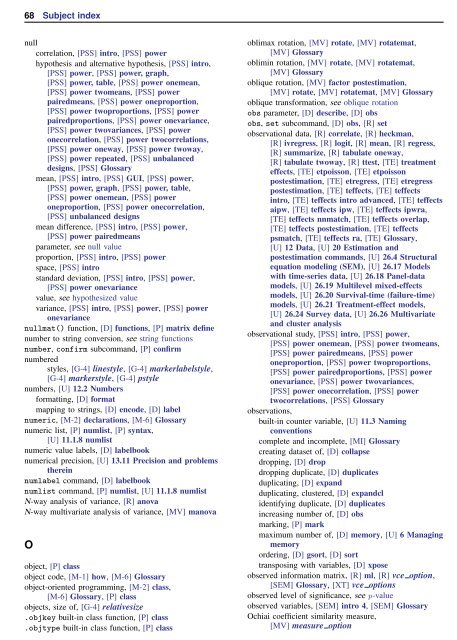Subject index - Stata
Subject index - Stata
Subject index - Stata
You also want an ePaper? Increase the reach of your titles
YUMPU automatically turns print PDFs into web optimized ePapers that Google loves.
68 <strong>Subject</strong> <strong>index</strong><br />
null<br />
correlation, [PSS] intro, [PSS] power<br />
hypothesis and alternative hypothesis, [PSS] intro,<br />
[PSS] power, [PSS] power, graph,<br />
[PSS] power, table, [PSS] power onemean,<br />
[PSS] power twomeans, [PSS] power<br />
pairedmeans, [PSS] power oneproportion,<br />
[PSS] power twoproportions, [PSS] power<br />
pairedproportions, [PSS] power onevariance,<br />
[PSS] power twovariances, [PSS] power<br />
onecorrelation, [PSS] power twocorrelations,<br />
[PSS] power oneway, [PSS] power twoway,<br />
[PSS] power repeated, [PSS] unbalanced<br />
designs, [PSS] Glossary<br />
mean, [PSS] intro, [PSS] GUI, [PSS] power,<br />
[PSS] power, graph, [PSS] power, table,<br />
[PSS] power onemean, [PSS] power<br />
oneproportion, [PSS] power onecorrelation,<br />
[PSS] unbalanced designs<br />
mean difference, [PSS] intro, [PSS] power,<br />
[PSS] power pairedmeans<br />
parameter, see null value<br />
proportion, [PSS] intro, [PSS] power<br />
space, [PSS] intro<br />
standard deviation, [PSS] intro, [PSS] power,<br />
[PSS] power onevariance<br />
value, see hypothesized value<br />
variance, [PSS] intro, [PSS] power, [PSS] power<br />
onevariance<br />
nullmat() function, [D] functions, [P] matrix define<br />
number to string conversion, see string functions<br />
number, confirm subcommand, [P] confirm<br />
numbered<br />
styles, [G-4] linestyle, [G-4] markerlabelstyle,<br />
[G-4] markerstyle, [G-4] pstyle<br />
numbers, [U] 12.2 Numbers<br />
formatting, [D] format<br />
mapping to strings, [D] encode, [D] label<br />
numeric, [M-2] declarations, [M-6] Glossary<br />
numeric list, [P] numlist, [P] syntax,<br />
[U] 11.1.8 numlist<br />
numeric value labels, [D] labelbook<br />
numerical precision, [U] 13.11 Precision and problems<br />
therein<br />
numlabel command, [D] labelbook<br />
numlist command, [P] numlist, [U] 11.1.8 numlist<br />
N-way analysis of variance, [R] anova<br />
N-way multivariate analysis of variance, [MV] manova<br />
O<br />
object, [P] class<br />
object code, [M-1] how, [M-6] Glossary<br />
object-oriented programming, [M-2] class,<br />
[M-6] Glossary, [P] class<br />
objects, size of, [G-4] relativesize<br />
.objkey built-in class function, [P] class<br />
.objtype built-in class function, [P] class<br />
oblimax rotation, [MV] rotate, [MV] rotatemat,<br />
[MV] Glossary<br />
oblimin rotation, [MV] rotate, [MV] rotatemat,<br />
[MV] Glossary<br />
oblique rotation, [MV] factor postestimation,<br />
[MV] rotate, [MV] rotatemat, [MV] Glossary<br />
oblique transformation, see oblique rotation<br />
obs parameter, [D] describe, [D] obs<br />
obs, set subcommand, [D] obs, [R] set<br />
observational data, [R] correlate, [R] heckman,<br />
[R] ivregress, [R] logit, [R] mean, [R] regress,<br />
[R] summarize, [R] tabulate oneway,<br />
[R] tabulate twoway, [R] ttest, [TE] treatment<br />
effects, [TE] etpoisson, [TE] etpoisson<br />
postestimation, [TE] etregress, [TE] etregress<br />
postestimation, [TE] teffects, [TE] teffects<br />
intro, [TE] teffects intro advanced, [TE] teffects<br />
aipw, [TE] teffects ipw, [TE] teffects ipwra,<br />
[TE] teffects nnmatch, [TE] teffects overlap,<br />
[TE] teffects postestimation, [TE] teffects<br />
psmatch, [TE] teffects ra, [TE] Glossary,<br />
[U] 12 Data, [U] 20 Estimation and<br />
postestimation commands, [U] 26.4 Structural<br />
equation modeling (SEM), [U] 26.17 Models<br />
with time-series data, [U] 26.18 Panel-data<br />
models, [U] 26.19 Multilevel mixed-effects<br />
models, [U] 26.20 Survival-time (failure-time)<br />
models, [U] 26.21 Treatment-effect models,<br />
[U] 26.24 Survey data, [U] 26.26 Multivariate<br />
and cluster analysis<br />
observational study, [PSS] intro, [PSS] power,<br />
[PSS] power onemean, [PSS] power twomeans,<br />
[PSS] power pairedmeans, [PSS] power<br />
oneproportion, [PSS] power twoproportions,<br />
[PSS] power pairedproportions, [PSS] power<br />
onevariance, [PSS] power twovariances,<br />
[PSS] power onecorrelation, [PSS] power<br />
twocorrelations, [PSS] Glossary<br />
observations,<br />
built-in counter variable, [U] 11.3 Naming<br />
conventions<br />
complete and incomplete, [MI] Glossary<br />
creating dataset of, [D] collapse<br />
dropping, [D] drop<br />
dropping duplicate, [D] duplicates<br />
duplicating, [D] expand<br />
duplicating, clustered, [D] expandcl<br />
identifying duplicate, [D] duplicates<br />
increasing number of, [D] obs<br />
marking, [P] mark<br />
maximum number of, [D] memory, [U] 6 Managing<br />
memory<br />
ordering, [D] gsort, [D] sort<br />
transposing with variables, [D] xpose<br />
observed information matrix, [R] ml, [R] vce option,<br />
[SEM] Glossary, [XT] vce options<br />
observed level of significance, see p-value<br />
observed variables, [SEM] intro 4, [SEM] Glossary<br />
Ochiai coefficient similarity measure,<br />
[MV] measure option

















